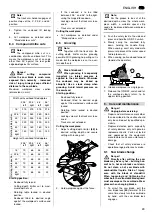
23
ENGLISH
3
Note:
The track arm holder engages at
positive stops at the 0°, 22.5°, and 45°
position.
4.
Tighten the sawhead tilt locking
lever.
5.
Cut workpiece as detailed under
"Standard cross cuts".
8.4
Compound mitre cuts
3
Note:
The compound mitre cut is a
combination of mitre and bevel cut. This
means the workpiece is cut at an angle
other than 90° against the rear guide
edge
and
against its surface.
A
Danger!
When cutting compound
mitres the saw blade is much more
exposed than normally - increased
risk of injury. Always keep sufficient
distance to the saw blade.
Maximum workpiece cross section
(dimensions in mm):
Starting position:
−
Sawhead fully raised.
−
Cutting depth limiter set to maxi-
mum depth of cut.
−
Rotating table locked in desired
position.
−
Sawhead tilted to desired angle
against the workpiece's surface and
locked.
−
If the sawhead is to be tilted
between 22.5 ° and 48° to the right,
swing the hinged fence down.
−
Locking screw of the track arm loos-
ened.
−
Track arm not extended.
Cutting the workpiece:
•
Cut workpiece as detailed under
"Standard cross cuts".
8.5
Grooving
3
Note:
Together with the track arm, the
cutting depth limiter makes grooving
possible. With grooving no parting cut is
made, but the workpiece is cut to a cer-
tain depth only.
A
Risk of kickback!
When grooving it is especially
important no lateral pressure is
applied to the saw blade. Otherwise
the sawhead may be kicked up
abruptly! Use a stock clamp when
grooving. Avoid lateral pressure on
the sawhead.
Starting position:
−
Sawhead fully raised.
−
Sawhead tilted to desired angle
against the workpiece's surface and
locked.
−
Rotating table locked in desired
position.
−
Locking screw of the track arm loos-
ened.
−
Track arm not extended.
Cutting the workpiece:
1.
Adjust cutting depth limiter
to
desired cutting depth and secure
setting with locking nut.
2.
Hold workpiece against the fence.
3
Note:
For the groove to be cut at the
desired depth across the whole work-
piece width, a suitable spacer strip
needs to be placed between workpiece
and fence.
3.
Push the safety lock to the side and
press and hold the ON/OFF switch.
4.
Slowly swing the sawhead fully
down, holding the handle firmly.
When sawing, exert only moderate
pressure to prevent the motor speed
to drop too much.
5.
When sawing, pull sawhead forward
(towards the operator).
6.
Groove workpiece in a single pass.
7.
Release the ON/OFF switch and let
the sawhead slowly return to its
upper starting position.
A
Danger!
Unplug before servicing.
−
Repair and maintenance work other
than described in this section should
only be carried out by qualified spe-
cialists.
−
Replace defective parts, especially
of safety devices, only with genuine
replacement parts. Parts not tested
and approved by the equipment
manufacturer can cause unforeseen
damage.
−
Check that all safety devices are
operational again after each service.
9.1
Saw blade change
A
Danger!
Directly after cutting the saw
blade may be very hot – burning haz-
ard! Let a hot saw blade cool down.
Do not clean a hot saw blade with
combustible liquids. Risk of injury,
even with the blade at standstill.
When loosening and tightening the
arbor bolt, the retractable blade guard
must encompass the saw blade. Wear
gloves when changing blades.
1.
To arrest the saw blade, pull the
saw blade lock
forward. At the
same time slowly turn the saw blade
by hand, until the saw blade lock
engages.
Width with sawhead tilted approx.
22.5 °
left
22.5 °
right
48 °
left
48 °
right
Rotating tabl
e position
15° 275
275
275
275
22.5° 260
260
260
260
30° 245
245
245
245
45° 200
200
200
200
50° 180
180
180
180
60°
right
140
140
140
140
Height with sawhead tilted approx.
22.5 °
left
22.5 °
right
48 °
left
48 °
right
Ro
ta
tin
g
ta
ble po
siti
on
15° 70
65
45
20
22.5° 70
65
45
20
30° 70
65
45
20
45° 70
65
45
20
50° 70
65
45
20
60°
right
70
65
45
20
49
9.
Care and maintenance
1
2

































